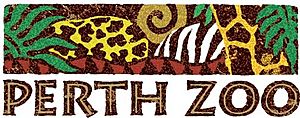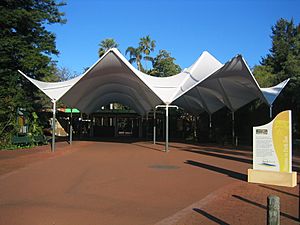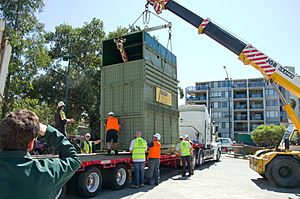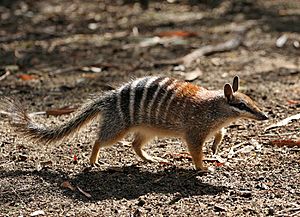Perth Zoo facts for kids
 |
|

Perth Zoo entrance
|
|
| Date opened | 1898 |
|---|---|
| Location | Perth, Western Australia |
| Land area | 41 acres (17 ha) |
| Coordinates | 31°58′39″S 115°51′11″E / 31.97750°S 115.85306°E |
| No. of animals | 1258 |
| No. of species | 164 |
| Annual visitors | 717,623 (2018-2019) |
| Memberships | ZAA, WAZA |
Perth Zoo is a fun zoo in South Perth, Western Australia. It covers about 41 acres of land. The zoo first opened its doors in 1898. By 2011, it was home to 1258 animals from 164 different species. It also has an amazing collection of plants.
Perth Zoo is a full member of the Zoo and Aquarium Association (ZAA) and the World Association of Zoos and Aquariums (WAZA). This means it's part of a big network of zoos working together.
History of Perth Zoo
The Perth Zoological Gardens first opened on October 17, 1898. The Governor of Western Australia, Lieutenant-Colonel Sir Gerard Smith, officially opened it.
Planning for the zoo began in 1896. A group called the Acclimatisation Society wanted to bring European animals to Australia. They also wanted to create a zoo to help protect animals. In 1897, they asked Albert Le Souef, the director of the Melbourne Zoo, to help choose a spot. His son, Ernest, became the first director of Perth Zoo. Work started in 1897 to build the zoo.
The first animal homes included two caves for bears and a house for monkeys. There was also a building for other mammals and a model castle for guinea pigs. The first animals to live at the zoo were an orangutan, two monkeys, four ostriches, a pair of lions, and a tiger. Only six staff members worked there at first. In its first nine months, the zoo had 53,000 visitors! It stayed open every day until March 24, 2020, when it temporarily closed due to the coronavirus outbreak.
From the very beginning, Ernest Le Souef wanted to create a plant collection too. He believed it was just as important as the animal collection. Work on the gardens started as soon as the zoo's location was chosen. The land was mostly sand and didn't have many nutrients or water. So, lots of manure was brought in, and a well was dug in 1898 to water the plants.
The zoo's gardens included beautiful rose gardens, fields of lupins, tropical plants, and many types of palms. The original palm collection is still there today! It has over 61 species, including Canary Island date palms that are more than 110 years old. The zoo also grew food for the animals, like lettuce, carrots, and onions. This tradition continues today, with the zoo growing plants like hibiscus and bamboo for its animals.
In 2010/11, the zoo had about 248 paid staff members. Plus, around 300 volunteers helped out.
Explore the Exhibits
Perth Zoo has three main areas to explore: the Australian Walkabout, the Asian Rainforest, and the African Savannah. There are also a few smaller areas like Lesser Primates, South American birds, the Main Lake, and Galapagos Tortoises. All the exhibits are designed to look like the animals' real homes in nature. They use clever ways to separate visitors from animals without big, obvious fences.
Australian Walkabout
The Australian Walkabout takes you on a journey through Australia's amazing landscapes. This area includes the Australian Wetlands, Penguin Plunge, Reptile Encounter, Australian Bushwalk, aviaries (bird homes), and the Nocturnal House.
Australian Wetlands and Penguin Plunge
The Australian Wetlands is home to many water birds like black swans, brolgas, and little pied cormorants. You can also see estuarine crocodiles, freshwater crocodiles, and different kinds of frogs and turtles. The Penguin Plunge is where you'll find little penguins and bridled terns. This exhibit has a huge 50,000-liter pool of filtered salt water. You can even watch the penguins swim underwater!
Australian Bushwalk
The Australian Bushwalk lets you walk through different Australian environments. Here you can spot dingoes, emus, koalas, numbats, quokkas, red kangaroos, and Tasmanian devils. There's a special area for Western Australian Black Cockatoos. It's planted with trees they love to eat. You can see Baudin's cockatoos, Carnaby's cockatoos, and red-tailed black cockatoos here. Another path leads to the Numbats Under Threat exhibit. This area highlights the endangered Australian numbat.
Nocturnal House
The Nocturnal House is designed so you can walk around and see animals that are active at night. It's like walking around Australia under a simulated moonlight! Animals you might see include bilbys, chuditches, ghost bats, spinifex hopping mouses, and different types of pythons. You'll also find some cool invertebrates like the whistling tarantula and spiny leaf insect.
Reptile Encounter
The Reptile Encounter opened in 1997. It has 17 exhibits that look just like the animals' natural homes. This building is climate-controlled, so it's always the right temperature for the reptiles. You can see many different reptile species from around the world. These include Bell's hinge-back tortoises, black-headed pythons, frill-necked lizards, boa constrictors, perenties, and various types of skinks and pythons.
African Savannah
The African Savannah exhibit replaced older, caged areas. It was the biggest building project at the zoo when it was made. This area looks like the wide-open African grasslands. You can see African painted dogs, African lions, Grant's zebras, hamadryas baboons, meerkats, Rothschild's giraffes, spotted hyenas, and southern white rhinoceroses. Visitors walk along a path that looks like a dry riverbed to view the animals.
Asian Rainforest
The Asian Rainforest is home to many Asian animals that are facing threats in the wild. Here you can find Asian elephants, Komodo dragons, red pandas, Sumatran orangutans, Sumatran tigers, and sun bears. There are also two exhibits for northern white-cheeked gibbons. Perth Zoo helps protect many of these species in their natural homes. The zoo's program for breeding Sumatran orangutans is the most successful in the world. They have bred 27 orangutans since 1970! Some zoo-born orangutans have even been released into the wild in Sumatra to help grow the wild population.
Lesser Primates
The Lesser Primates exhibit is where you'll find smaller monkeys and lemurs. This area is home to ring-tailed lemurs, black-and-white ruffed lemurs, tufted capuchins, cotton-top tamarins, emperor tamarins, and pygmy marmosets.
Amazonia
Between the African Savannah and the Nocturnal House, you'll find a series of bird enclosures called Amazonia. These are home to golden lion tamarins, Bolivian squirrel monkeys, and South American coatis.
Galapagos Tortoises
Next to the African Savannah, you can visit an exhibit that is home to two huge Galapagos tortoises.
Main Lake
Near the zoo's entrance is the Main Lake. It has two islands. One island is home to a group of black-and-white ruffed lemurs. The other island has a family of Javan gibbons. Close to the Main Lake, you'll also find exhibits for the southern cassowary and the Goodfellow's tree kangaroo. You can also see Australian pelicans swimming in the lake.
Talking Zoo
Perth Zoo offers a free online service called Talking Zoo. You can download information about the animals onto your phone or MP3 player. This lets you learn more as you walk around the zoo!
Heritage Trail
The Heritage Trail is a self-guided walk around the zoo. You can get a map from the Information Centre or download it online. This trail shows you the zoo's historical buildings. You'll see old sheds, the bear caves, and even a carousel from 1947 that is still used today!
- African Savannah
- African painted dog
- African lion
- Cape porcupine
- Grant's zebra
- Hamadryas baboon
- Radiated tortoise
- Rothschild giraffe
- Slender-tailed meerkat
- Spotted hyena
- Southern white rhinoceros
- Asian Rainforest
- Asian elephant
- Binturong
- Komodo dragon
- Nepalese red panda
- Northern white-cheeked gibbon
- Small-clawed otter
- Sumatran orangutan
- Sumatran tiger
- Sun bear
- Australian Bushwalk
- Dingo
- Emu
- Koala
- Numbat
- Quokka
- Red kangaroo
- Rufous whistler
- Short-beaked echidna
- Southern hairy-nosed wombat
- Tammar wallaby
- Tasmanian devil
- Western brush wallaby
- Western grey kangaroo
- Cockatoos and Parrots
- Baudin's cockatoo
- Carnaby's cockatoo
- Major Mitchell's cockatoo
- Muir's corella
- Red-tailed black cockatoo
- Red-capped parrot
- Australian Wetlands
- Black swan
- Black-necked stork
- Brolga
- Little pied cormorant
- Blue-billed duck
- Freckled duck
- Australian shelduck
- Radjah shelduck
- Eurasian coot
- Yellow-billed spoonbill
- Black-winged stilt
- Little egret
- Pied heron
- Plumed whistling duck
- Nankeen night heron
- Estuarine crocodile
- Freshwater crocodile
- Motorbike frog
- Splendid tree frog
- Western swamp tortoise
- Pig-nosed turtle
- Oblong turtle
- Merten's water monitor
- Penguin Plunge
- Main Lake
- Nocturnal House
- Banded knob-tailed gecko
- Bilby
- Cane toad
- Chuditch
- Dibbler
- Ghost bat
- Green tree frog
- Spinifex hopping mouse
- Rakali water rat
- Red-tailed phascogale
- Rough-scaled python
- Jungle carpet python
- Stimson's python
- Rough-throated leaftail gecko
- Owlet-nightjar
- Tawny frogmouth
- Western ringtail possum
- Southern brown bandicoot
- Long-nosed potoroo
- Sugar glider
- Ringtail possum
- Feathertail glider
- Brush-tailed bettong
- Sunda slow loris
- Reptile Encounter
- Bell's hinge-back tortoise
- Black-headed python
- Dugite
- Frill-necked lizard
- Tokay gecko
- Pebble-mimic dragon
- Inland bearded dragon
- Olive python
- Perentie
- Boa constrictor
- Pygmy python
- Burmese python
- South-west carpet python
- Common death adder
- Tiger snake
- Dampier Peninsula monitor
- Western blue-tongued skink
- Northern blue-tongued skink
- Shingleback skink
- Western spiny-tailed skink
- Woma python
- Lesser Primates
- Tufted capuchin
- Common marmoset
- Cotton-top tamarin
- Emperor tamarin
- Pygmy marmoset
- Ring-tailed lemur
- Black-and-white ruffed lemur
- Amazonia
- Galapagos Tortoises
- South American Birds
- Walk-In Aviary
- Blue-winged kookaburra
- Channel-billed cuckoo
- Eclectus parrot
- Emerald dove
- Green pygmy goose
- Pheasant coucal
- Pied imperial pigeon
- Invertebrates in Nocturnal House
Conservation Efforts

Perth Zoo plays a big role in helping save endangered species. They have special breeding programs for both Australian animals and animals from other parts of the world. These programs have led to many successful births, including Rothschild's giraffes, white rhinoceroses, Sumatran tigers, and orangutans. Some Australian animals are bred to be released back into safe areas in Western Australia. The international animals help increase the variety of genes in zoo populations around the world.
Saving Exotic Species
Since 2006, Perth Zoo has helped a lot with conservation projects in the Bukit Tigapuluh National Park in Sumatra. This park is home to many different kinds of animals and plants. The zoo is part of a worldwide program to release rescued orangutans back into the wild. These orangutans were often pets or orphans. The goal is to create a new wild population of this critically endangered ape. More than 139 orangutans have been released into the area, and some have even had babies!
In November 2006, Perth Zoo released Temara, a 14-year-old Sumatran orangutan born at the zoo. She was the first zoo-born orangutan ever released into the wild! In 2011, Semeru, the first male zoo-born orangutan, was also released. Perth Zoo works with other groups like the Frankfurt Zoological Society to help with this important work.
Perth Zoo also helps save threatened species in the wild through its fundraising program, Wildlife Conservation Action. This program started in 2007. The money raised has helped protect Sumatran orangutans, Sumatran tigers, African painted dogs, and many Australian native species. Over $881,000 has been raised since the program began!
Protecting Native Australian Species
Perth Zoo works with the Department of Environment and Conservation to breed threatened Western Australian animals. These animals are then released into protected areas in the wild. This is part of their Native Species Breeding Program. As of 2011, Perth Zoo breeds numbats, western swamp tortoises, dibblers, woylies, and threatened Western Australian frog species.
Numbat Reproduction and Conservation
The numbat is Western Australia's mammal symbol. It's one of only two marsupials that are active during the day. The numbat is the only Australian mammal that eats only termites. Even though some populations have been started by the Department of Environment and Conservation, the numbat is still listed as endangered by the IUCN. Perth Zoo has been breeding numbats for release into the wild since 1986. The first successful birth was in 1993. By early 2011, the zoo had provided 165 numbats for release into safe habitats.
Western Swamp Tortoise Life Cycle and Conservation
The western swamp tortoise is a small freshwater turtle. It's Australia's most critically endangered reptile. This tortoise has only been found in a small strip of land near Perth. Since 1988, Perth Zoo has bred more than 500 western swamp tortoises. The biggest challenge to helping this species is finding enough suitable places for them to live.
Dibbler Reproduction and Conservation
The dibbler is a small meat-eating marsupial. It's found on two islands off Jurien Bay and on the south coast of Western Australia. It used to live in many more places, but now it's listed as endangered by the IUCN. Dibblers bred at Perth Zoo were used to start a new population on Escape Island. Now, the zoo focuses on breeding dibblers from Fitzgerald River National Park to release on the mainland. By early 2011, over 500 dibblers had been provided by the zoo for release.
The frog breeding program aims to increase the numbers of threatened frog species. This includes the vulnerable Spicospina flammocaerulea (Sunset Frog), Geocrinia vitellina (Orange-bellied Frog), and the critically endangered Geocrinia alba (White-bellied Frog).
Images for kids
See also
 In Spanish: Zoológico de Perth para niños
In Spanish: Zoológico de Perth para niños













